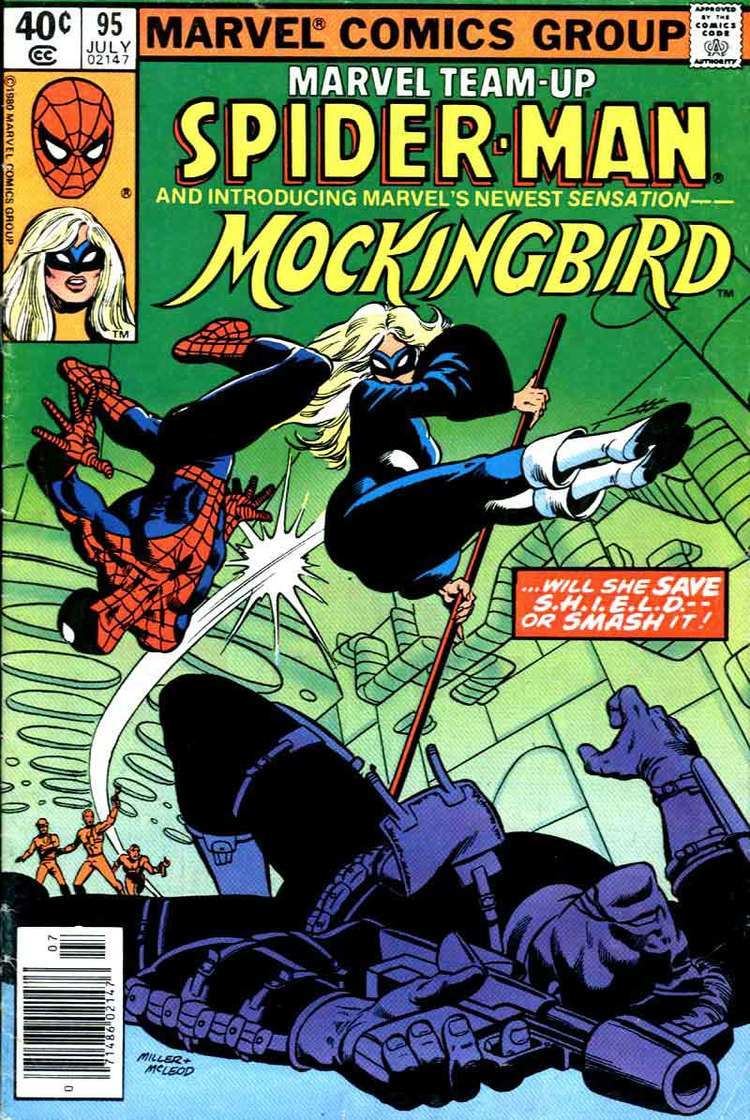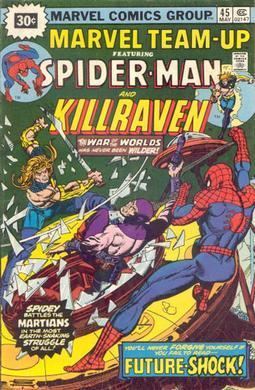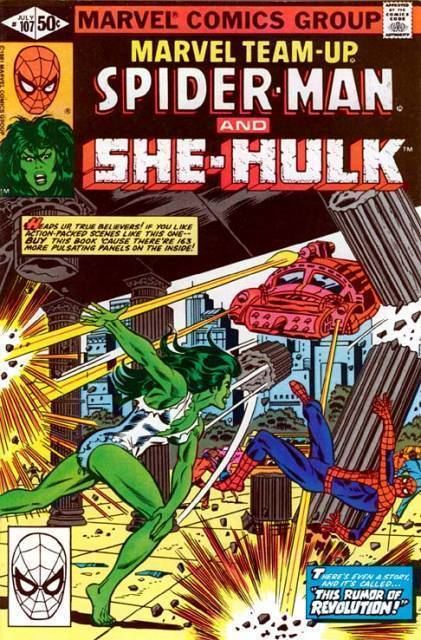Format Ongoing | ||
 | ||
Schedule Marvel Team-Up (all): monthlySpider-Man Team-Up: quarterly Publication date Marvel Team-Up : March 1972 - February 1985Spider-Man Team-Up: December 1995 - June 1997Marvel Team-Up (vol. 2): September 1997 - July 1998Marvel Team-Up (vol. 3): January 2005 - December 2006 Number of issues Marvel Team-Up (vol. 1): 150 and 7 AnnualsSpider-Man Team-Up: 7Marvel Team-Up (vol. 2): 11Marvel Team-Up (vol. 3): 25 Inker(s) Terry Austin, Mike Esposito Writers Pencillers Ross Andru, Sal Buscema, John Byrne, Bob Hall, Gil Kane, Greg LaRocque, Frank Miller, Jim Mooney, Ron Wilson Similar | ||
Spider man marvel team up 45 future shock untimed
Marvel Team-Up is the name of several American comic book series published by Marvel Comics. The series featured two or more Marvel characters in one story. The original series was published from March 1972 through February 1985, and featured Spider-Man as the lead "team-up" character in all but ten of its 150 issues, and in six of its seven annuals. It was the first major ongoing spin-off series for Spider-Man, being preceded only by the short-lived The Spectacular Spider-Man magazine. Of the issues that did not star Spider-Man, the Human Torch headlines six issues (#18, 23, 26, 29, 32, 35); the Hulk, four (#97, 104, 105, and Annual #3); and Aunt May, one (#137). Publication of most of the issues starring the Human Torch coincided with that of Giant-Size Spider-Man, an alternate Spider-Man "team-up"-themed series by the regular Marvel Team-Up creative team. When cancelled with #150, the title was replaced by Web of Spider-Man.
Contents
- Spider man marvel team up 45 future shock untimed
- Spider man and the vision visions of hate marvel team up 42 timed
- Publication history
- Volume 1
- Spider Man Team Up
- Volume 3
- References

The second series was published for 11 issues from September 1997 through July 1998 and originally featured Spider-Man; Namor the Sub-Mariner was the featured character starting with #8. From 1995 to 1997, a quarterly series titled Spider-Man Team-Up fulfilled much the same purpose as the original title. The third Marvel Team-Up series, written by Robert Kirkman, began publication in January 2005 and frequently featured Spider-Man. This volume often reintroduced lesser-known Marvel characters that had fallen into obscurity.

The spirit of Marvel Team-Up was carried on by Avenging Spider-Man and later Superior Spider-Man Team-Up.
Spider man and the vision visions of hate marvel team up 42 timed
Publication history
Comics journalist Jonathan Miller summarized Marvel Team-Up in a retrospective article:

The series was admittedly formulaic; either Spider-Man or that issue's guest-star would encounter a menace and then by sheer chance cross paths with another hero who would lend a hand. The title's guest-stars were an equal mix of A-list characters whose presence was likely to increase sales and fledgling heroes being given exposure in the hopes of launching them into stardom but who for the most part continued to languish in obscurity.

The series debuted with a March 1972 cover-dated issue featuring Spider-Man and the Human Torch in a story by writer Roy Thomas and artist Ross Andru. Spider-Man and the Human Torch were originally the permanent headliners on the series, but the creators found this format limiting, and after just three issues the Human Torch was dropped in favor of a rotating co-star slot. The main artists on the series for the first several years were Andru, Gil Kane, Sal Buscema, and Jim Mooney.

In 1974, Marvel started publishing Giant-Size Spider-Man, which was a quarterly 68-page comic that lasted for six issues which complemented Marvel Team-Up. The series featured team-ups, with each issue featuring a new story with a back-up reprint, except the last issue, which only featured a reprint.
Due to the limitations of the typically single-issue team-up stories, the supporting cast of Spider-Man's other titles rarely appeared in Marvel Team-Up. The series often featured non-superhero characters in the co-star slot. A multi-issue time travel story arc began in issue #41 with Spider-Man and the Scarlet Witch traveling to the Salem witch trials in 1692, and pushed the barriers of continuity by having Spider-Man team up with characters who had no established connection to the mainstream Marvel Universe, such as Deathlok. Though the series did often team Spider-Man with other highly popular characters, it regularly gave the co-star slot to obscure characters that the average reader was unlikely to even recognize, particularly during writer J. M. DeMatteis's run. DeMatteis recounted, "I was always attracted to the more obscure characters, mainly because they were ripe for exploration. You could crack them open and really develop them. ... I just looked at these fringe characters as more inviting than the mainstream, more established characters - who all had their set-in-stone continuity. I wanted room to play and those characters gave me all the room I wanted. And let's fact it, our lead character was as mainstream as you can get, so the obscure ones made for a nice contrast."
With issue #47, the series had a crossover with Marvel Two-in-One #17, which featured the Thing. Jean DeWolff was introduced as a supporting character in the Spider-Man/Iron Man story in issue #48.
John Byrne, who would later become the artist on The Uncanny X-Men, first drew the characters in Marvel Team-Up #53. Byrne and his Uncanny X-Men collaborator, writer Chris Claremont worked together on several issues of Marvel Team-Up. Captain Britain, a character created for Marvel UK, made his first appearance in an American comic book in Marvel Team-Up #65 (January 1978).
Karma, a character that later joined the New Mutants, was created by Claremont and artist Frank Miller in #100's lead story. A photo cover by Eliot R. Brown was used for the Spider-Man/Captain America team-up in issue #128.
Though published for well over a decade, the series format never truly caught on with readers. Upon taking a serious look at sales figures for Marvel Team-Up, Marvel's editorial staff found that sales dramatically rose or fell with each issue depending solely on the popularity of that issue's co-star. Taking this into consideration, Marvel editor-in-chief Jim Shooter concluded that it would make more sense to have another Spider-Man solo series with guest stars appearing when the storyline and/or promotional needs called for it, rather than a team-up series which unnaturally forced guest-stars upon the story. The series ended with issue #150 (February 1985), to be replaced by Web of Spider-Man.
A Hulk and the Human Torch story written by Jack C. Harris and drawn by Steve Ditko in the 1980s that was intended for Marvel Team-Up was published by Marvel as Incredible Hulk and the Human Torch: From the Marvel Vault #1 in August 2011.
Spider-Man Team-Up was a brief attempt to revive the concept of the series and was soon followed by Marvel Team-Up vol. 2 which was published from September 1997 to July 1998. The third Marvel Team-Up series launched in January 2005 and ran for 25 issues which starred a variety of characters.
